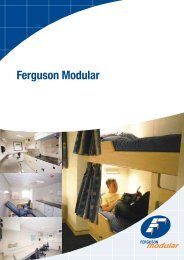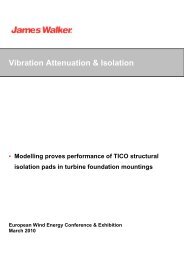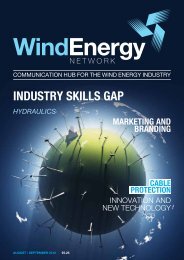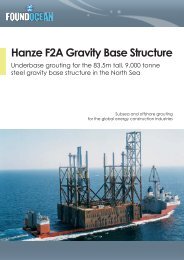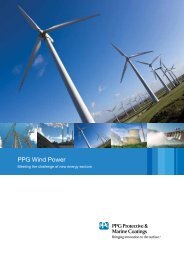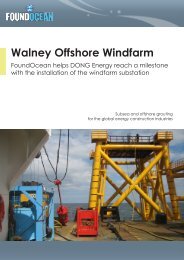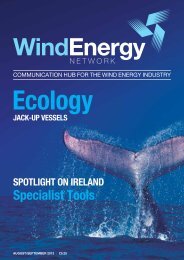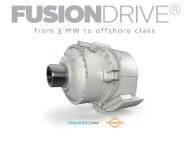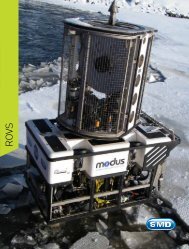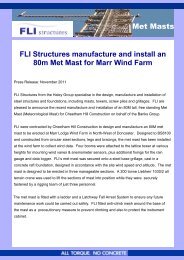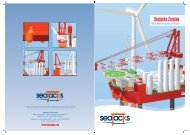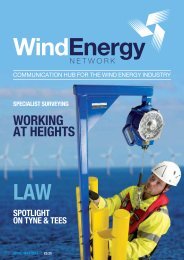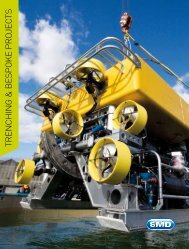JUNE/JULY 2013 | £5.25 - Wind Energy Network
JUNE/JULY 2013 | £5.25 - Wind Energy Network
JUNE/JULY 2013 | £5.25 - Wind Energy Network
Create successful ePaper yourself
Turn your PDF publications into a flip-book with our unique Google optimized e-Paper software.
legal eagleslegal eaglesContractual RiskAt a recent <strong>Wind</strong> Industry Event a verysenior procurement director madereference to the trend in contractstructures towards partnering,commenting that the only partneringhe understood was his marriage.Understanding differentcontractsThe increasing trend towards describingcontracts as co-operation agreements,partnering agreements, collaborationagreements, alliancing contract etcsometimes makes me wonder if thepeople who use the terminologyunderstand the differentiating features ofdifferent types of contracts and over thepast month or so since that conference Ihave asked people in the industry aboutthe nomenclature of contracts.Differing viewsThe responses suggest that there is adifferent view of the terms used dependingon who you ask and which area ofbusiness they are in. For an industry sofocused on risk assessment and allocationit is strange that the many involved in theindustry don’t fully understand the legaldistinctions which apply to the terminologyof types of contract leading to a situationwhere the terms are used interchangeably.This may arise from the use of manydifferent consultants in the supply chainand a desire on the part of developers tosave on the fees paid to lawyers, but alsoI suspect from consultants expressingcompetence in drafting, negotiating andclosing contracts.The desire for the developer to havea single source advisory team andcommercial pressures no doubt also havetheir part to play. The risk in this approachis something that goes largely ignored.The devil in the detailRecent high profile disputes on Offshore<strong>Wind</strong> projects suggest that lack ofattention to the detail of the contract canlead to lengthy and expensive disputes.Sometimes outcomes are matters of goodluck rather good drafting.So the issue becomes a choice of whichis the best form of contract. Is NEC3 thebest approach for Hinkley C, was NEC thebest approach for Glendoe and how doyou decide on the approach?Weighing up theoptionsSome advisors willhave a preferred formof contract because thatis what they are familiarwith. In fact the choiceof form of contract is aprimary factor in projectdelivery risk management.Getting the choice ofcontract wrong can lead tosignificant areas of risk. An example of thiscan be seen in alliancing contracts whencompared to collaboration agreements.In simple terms an alliance contract is justthat. It is bespoke agreement to servicethe needs of delivering a project. It is nota partnering agreement, a partnership aframework or a collaboration agreement.Purists believe that an alliancing contractshould have no dispute resolution processbecause of the nature of the contractwhich makes the parties subservient tothe alliance for the purpose of delivering aproject. Risk and cost sharing are on veryspecific basis.Other forms have particularstructures which meet the needs ofthe project.Professional adviceChoosing the right one is a goodrisk management exercise.Involving lawyers in the processis not only a good idea it can helpachieve an outcome which is thepreferred solution for the project.Understanding of contract assemblyfor a particular purpose is whatcommercial lawyers practising in thesector are trained to do.It should be remembered that acontract is essentially a statementof legal obligations and a deepunderstanding of the legal principlesbehind drafting of contracts is essential totheir effective management.Selecting the best form is not a matter offamiliarity for lawyers it is using the bestapproach to ensure the client needs arethe pre-eminent concern.Andrew RentonBird & Bird LLPwww.twobirds.comOnshore windlessons to be learnedWe are now on the second generation of onshorewind farms. Much has been learned technically andoperationally, but what lessons have been learned on thecontract side?Civils contractThe civils contract has been the origin of most of the disputesand there have been many. This is usually design and build withan originating technical specification from the client.Three major sources of disputes have emergedgenerally…• Design issues• Risk on earthworks• Risk during extended maintenance periodsDesign issuesThe main design issue has been around the adequacy of theturbine base design. PI insurers have been meeting claimsagainst designers for failure to design to meet the dynamicloadings imposed by the turbines. These disputes are now tailingoff as the design has developed.This has affected the design liability provisions in the civilscontract. Caps on or exclusions of liability for consequential lossare demanded as a matter of course by contractors.Where the turbine suppliers’ requirements are incorporatedwithin the civils contract, which is inevitably the case, there is realscope for conflict between them and the technical specification.A clear order of precedence of documents within the contract isneeded.EarthworksSlopes and gradients, and use of on-site material are criticalto the contractor’s price. The planning permission will normallydictate much of what can be done earthworks-wise with oftena ‘tolerance’ area, within which the turbine bases and thelocation of the access roads may be sited. These may notbe achievable. The question often raised is: when does the‘difficult to achieve’ in the way of gradients and slopes becomeimpossible? Impossibility of performance may be a ‘get out’ forthe contractor- simply being more expensive to achieve thananticipated, is not.Risk during extended maintenance periodsThe defects liability period under the civils contract is oftenset at two years. As well as an obligation to rectify defects,employers usually impose ongoing maintenance obligations onthe contractor during that period. The issue that often arises iswhere a repairing obligation ends and a maintenance obligationbegins. The turbine supplier may well have obtained earlypossession of site roads and groups of turbine bases beforeoverall completion. This can cause significant damage to theroads.Where responsibility for maintaining these roads rests with thecontractor until the end of the defects period, an issue that oftenarises is whether a contractor’s maintenance obligation extendsto repairs required as a result of the turbine delivery, rather thansimple wear and tear. Where the roads ought to have beendesigned to withstand turbine delivery, if they fail to do so, thisED’s Note This is an abridgedversion - we recommend youread the full text via the link atthe end of article.may constitute adefect under thecontract.These are just someexamples of thecommon issues ofcontention in thesecontracts.Lindy Patterson QCDundas & Wilsonwww.dundaswilson.comClick to viewmore info90 www.windenergynetwork.co.ukwww.windenergynetwork.co.uk 91



